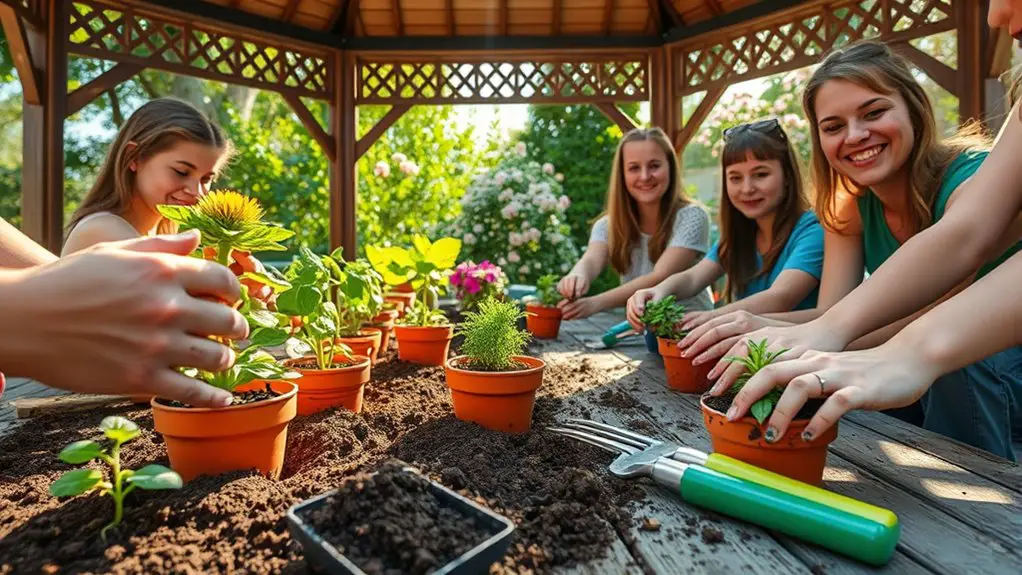Hosting planting workshops under your gazebo can be a delightful way to engage your community. Start by choosing native plants that thrive locally; they require less maintenance and support wildlife. Gather essential supplies like trowels, pots, and soil. Design an interactive agenda featuring hands-on demonstrations and time for sharing experiences. To attract participants, utilize social media and offer incentives. Finally, create a welcoming atmosphere with cozy seating and soft lighting. There’s much more to explore for a successful event!
Choosing the Right Plants for Your Workshop
When you’re planning a planting workshop under your gazebo, how do you choose the right plants? Start by considering native plants that thrive in your area. They’re not only beautiful but also support local wildlife and require less maintenance. Next, think about seasonal flowers to keep your garden vibrant throughout the year. For spring workshops, consider cheerful daffodils or tulips, while summer might call for sunflowers or zinnias. Autumn can be highlighted with chrysanthemums or asters. By selecting a mix of native plants and seasonal flowers, you’ll create a dynamic workshop that inspires creativity and joy. Additionally, incorporating climbing plants like the Raymond Evison Clematis can enhance vertical space around your gazebo. Remember, the right plants can transform your gazebo space into a thriving sanctuary, making your workshop an unforgettable experience.
Gathering the Necessary Supplies
As you prepare for your planting workshop under the gazebo, gathering the necessary supplies is essential to guarantee a smooth and enjoyable experience. Start with the right planting tools—trowels, gloves, and watering cans are must-haves. Consider the variety of soil types you’ll be working with; potting soil, garden soil, and compost can each support different plants effectively. Make sure to have enough containers or pots for your participants, along with labels for easy identification. Don’t forget to provide some basic resources like handouts or guides to help everyone understand their planting choices. Additionally, hosting this workshop in a gazebo can enhance the overall experience by providing adequate shade from the sun and a comfortable space for creativity. By ensuring you have everything organized beforehand, you’ll empower your participants to release their creativity and enjoy their planting experience to the fullest.
Designing an Engaging Workshop Agenda
To create a memorable planting workshop, you’ll want to design an agenda that captivates your participants and keeps them engaged throughout the experience. Start with an interactive icebreaker to foster connection, followed by a hands-on planting demonstration. Make sure to include time for participant interaction, allowing everyone to share their thoughts and experiences.
Here’s a sample agenda layout:
| Time | Activity | Goal |
|---|---|---|
| 10:00 – 10:15 | Icebreaker | Build rapport |
| 10:15 – 11:00 | Planting Demo | Teach essential techniques |
| 11:00 – 11:30 | Group Planting Activity | Encourage collaboration |
Keep the workshop duration in mind, ensuring you allow ample time for questions and shared experiences. This approach guarantees an engaging and memorable workshop! Additionally, hosting workshops under your gazebo can enhance outdoor experiences for outdoor comfort and connection to nature.
Promoting Your Event to Attract Participants
How can you effectively promote your planting workshop to attract participants? It’s all about reaching out and spreading the word. Here are four strategies to get you started:
- Utilize Social Media: Share engaging posts, images, and videos about your workshop on platforms like Facebook, Instagram, and Twitter.
- Create Event Pages: Use event management tools to organize details and allow participants to RSVP easily.
- Leverage Community Outreach: Connect with local gardening clubs, schools, and libraries to share your event; they might help spread the word.
- Offer Incentives: Consider providing free seeds or refreshments to encourage sign-ups and attendance. Additionally, considering size and available outdoor space will help you plan an appropriate setup for your gazebo event.
Creating a Welcoming Atmosphere in Your Gazebo
Creating a welcoming atmosphere in your gazebo can greatly enhance the experience of your planting workshop. Start by focusing on creating ambiance; soft lighting and natural decor can set a calming tone. Consider string lights or lanterns to add warmth as dusk approaches.
Next, think about enhancing comfort. Provide cozy seating options like cushions or blankets for participants to relax during demonstrations. A small refreshment station with water or herbal tea can also invite conversation and connection.
Don’t forget to personalize the space with plants or flowers that inspire creativity. Additionally, incorporating soft lighting can transform the overall experience, ensuring that participants feel more at ease and engaged. By curating a pleasing environment, you’ll not only engage your audience but also encourage them to feel at home, fostering a sense of community and freedom to explore their gardening passion.
Frequently Asked Questions
What Is the Ideal Time of Year for Planting Workshops?
The ideal time for planting workshops is in spring, when new growth begins, and in fall, perfect for gardening preparations. You’ll enjoy fresh ideas and techniques for nurturing your garden, embracing the freedom of seasonal planting!
How Many Participants Should I Invite for a Successful Workshop?
For a successful workshop, aim for an ideal group size of 8 to 12 participants. This fosters better engagement and interaction, allowing everyone to share ideas freely while ensuring personalized attention and a supportive atmosphere.
Can I Host Workshops for Different Skill Levels?
You can definitely host workshops for different skill levels—it’s like casting a wide net! By offering beginner techniques alongside advanced strategies, you’ll cater to everyone’s needs and create a vibrant, engaging learning environment.
What if It Rains on the Day of the Event?
If it rains on event day, don’t worry! Make rainy day preparations by having alternative activities ready, like indoor demonstrations or interactive games. This way, you’ll keep everyone engaged and learning, despite the weather.
How Do I Follow up With Participants After the Workshop?
To follow up with participants, send a follow-up email, include a feedback survey, express gratitude for their attendance, and invite them to share their thoughts. This keeps connections strong and encourages future engagement.

